Agenda and Outcomes
Agenda/key takeaways
- What is pneumonia?
- Various types of pneumonia.
- Major causes of pneumonia.
- Signs and symptoms of pneumonia.
- Pneumonia treatment methods.
Pneumonia is an infection caused by inflammation of air sacs.
It can either affect one or both lungs, which may be filled with fluid or pus.
Majorly caused by:
- Bacteria;
- Fungi;
- Virus.
Viral pneumonia causes include: respiratory syncytial virus (RSV) and influenza.
Pneumococcus(streptococcus pneumonia) commonly constitute bacterial pneumonia.
Fungal pneumonia is often caused by bird droppings or soil fungi.
In most cases, fungal pneumonia affects people with weak immune systems:
- Pneumonia symptoms can vary from so mild such that they are barely noticeable to severe that hospitalization is required.
- The way a body responds to pneumonia depends on the type of germ causing the infection, age and a person’s overall health.
- With pneumonia, germs cause air sacs in lungs to inflame and become full of acid.
- This inflammation causes coughing, fever chills and breathing difficulties which can be life-threatening.
Life threating symptoms of pneumonia include:
- Fast heart rate
- Low blood pressure
- Vomiting and diarrhea
- Shivering
Major types of pneumonia include:
- Community-acquired pneumonia (CAP)
- Hospital-acquired pneumonia (HAP)
Community-acquired pneumonia is developed outside the hospital while hospital acquired develops during hospital stays.
Hospital acquired pneumonia occurs in two ways namely:
- Ventilator-associated pneumonia (VAP-HAP)
- Non-ventilator associated pneumonia (NV-HAP)
Ventilator-associated pneumonia occurs to patients who are on a ventilator while non ventilator-associated pneumonia develops in patients not under ventilation:
- Pneumonia symptoms can vary from so mild such that they are barely noticeable to severe that hospitalization is required.
- The way a body responds to pneumonia depends on the type of germ causing the infection, age and a person’s overall health.
- With pneumonia, germs cause air sacs in lungs to inflame and become full of acid.
- This inflammation causes coughing, fever chills and breathing difficulties which can be life-threatening.
- Examples of mild symptoms are loss of appetite, fever, sweating and chills.
- Life threating symptoms of pneumonia include:
- Fast heart rate
- Low blood pressure
- Vomiting and diarrhea
- Shivering
- Both the types of pneumonia and general health of a patient determine pneumonia treatment
- Patients with bacterial pneumonia are advised to always finish the entire antibiotics course even if they start feeling better.
- Anti-fungal medications treat fungal pneumonia and need to be taken for several weeks to clear the infection.
- Many viral pneumonia cases clear on their own but on some cases, doctors might give a prescription of antivirals.
Outcomes
The audience will be able to;
- Define pneumonia;
- Identify the various types of pneumonia;
- Describe the treatment methods of pneumonia;
- Differentiate between:
- mild pneumonia symptoms;
- Severe pneumonia symptoms.
- By learning about causes of pneumonia, the audience will take necessary precautions to prevent infection of pneumonia.
- These precautions include:
- Observing oral hygiene
- Eating right with plenty of fruits and vegetables.
- Staying away from sick people if possible.
- These precautions result to a general advantage as it contributes to the overall health in a society.
- Incase of infection, the audience will be able to analyze the signs and symptoms and therefore take appropriate medication.
- They will also be aware of severe symptoms and therefore seek immediate medical attention.
- Through knowledge acquired from this presentation, the audience can run pneumonia awareness campaigns in their respective geographical areas.
- This will help reach a larger audience hence more reduction in annual pneumonia cases.
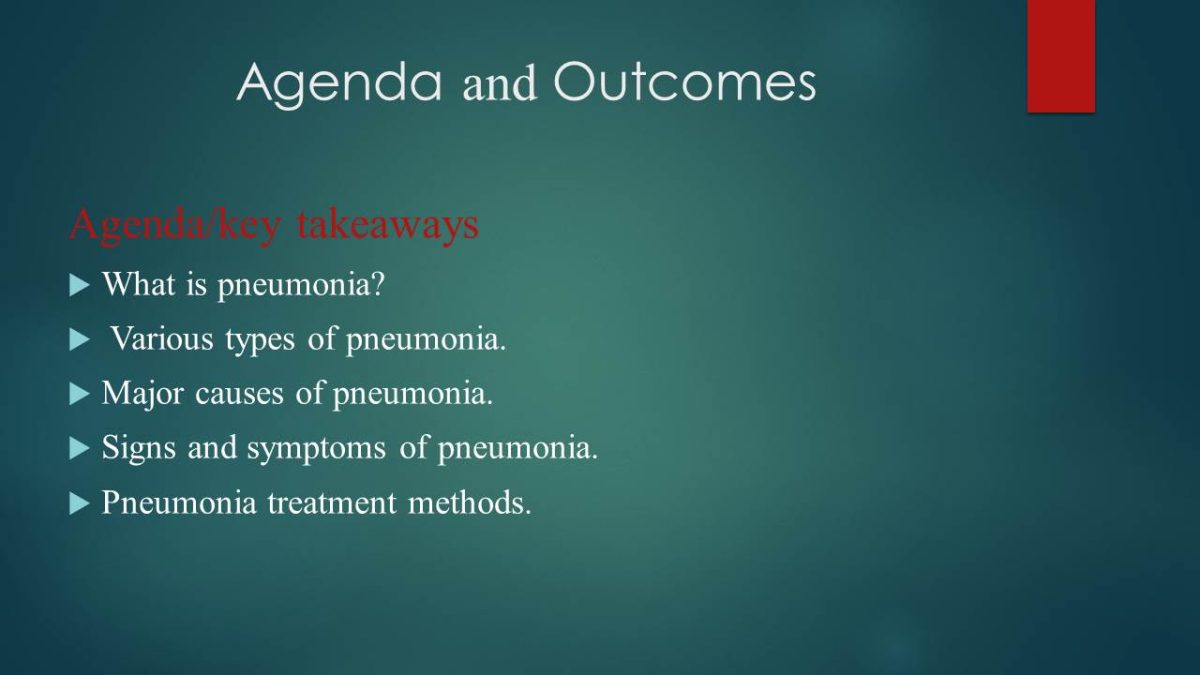

Safety Improvement Plan
- VAP is the most frequent hospital-acquired bacterial infection.
- It is difficult to treat nosocomial Gram-negative bacteria causing VAP (Rhodes et al., 2018).
- Dissemination of pan- and multi-drug resistant strains have become a problem.
- Ventilated-associated pneumonia has no approved antibiotics agents.
- Among ventilated patients, Ventilated-associated pneumonia is the most frequent type of pneumonia.
- Patients with Ventilated-associated pneumonia represent a population at risk of antibiotic-failure due to altered antibiotic pharmacokinetic parameters.
- Evolution and dissemination of Multi-drug resistant and pan-drug resistant strains have left health practitioners with inadequate treatment options.
- Since no antibiotics agents for Ventilated-associated pneumonia have been approved, it is anticipated that the situation of antibiotic-failure crisis will worsen.
- Multi-Drug Resistance(MDR) was defined as acquired non-susceptibility to at least one agent in three or more antimicrobial categories.
- Pan Drug Resistance(PDR) is defined as non susceptibility to all agents in all antimicrobial categories.
- Safety improvement plan addresses implementation of oral care (Munro et al., 2018).
- (NV-HAP) incidents have reduced from 105 to 8.3 cases in every 1000 patient-days.
- Healthcare costs associated with (NV-HAP) have reduced.
- High quality oral care tools have been developed in hospitals.
- Effective oral care across hospitals has reduced the costs of (NV-HAP) care.
- oral care initiative has reduced the risks associated with non-ventilator-associated pneumonia
- Reduction of NV-HAP cases incidents has yielded cost estimate avoidance of$2.84 million and several lives saved.
- Through provision of high-quality, evidence-based oral care tools, hospitals have achieved two important goals:
- Making oral care interventions safer.
- Illustrating commitment of the hospital to oral care enhancement.
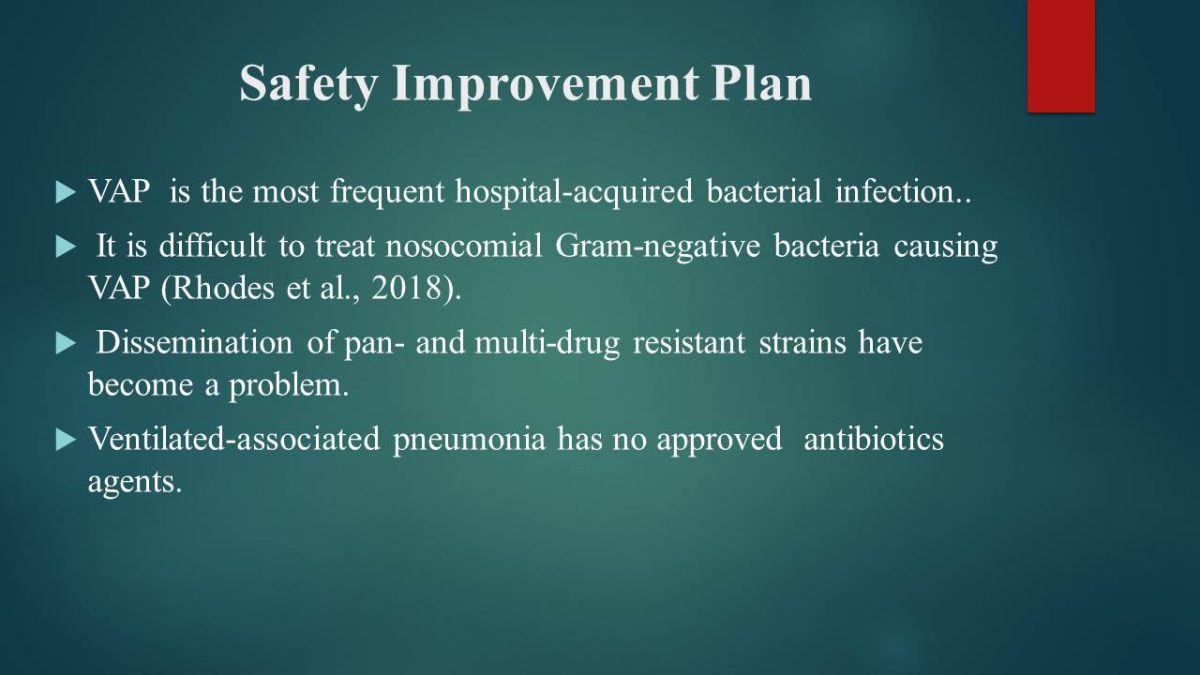
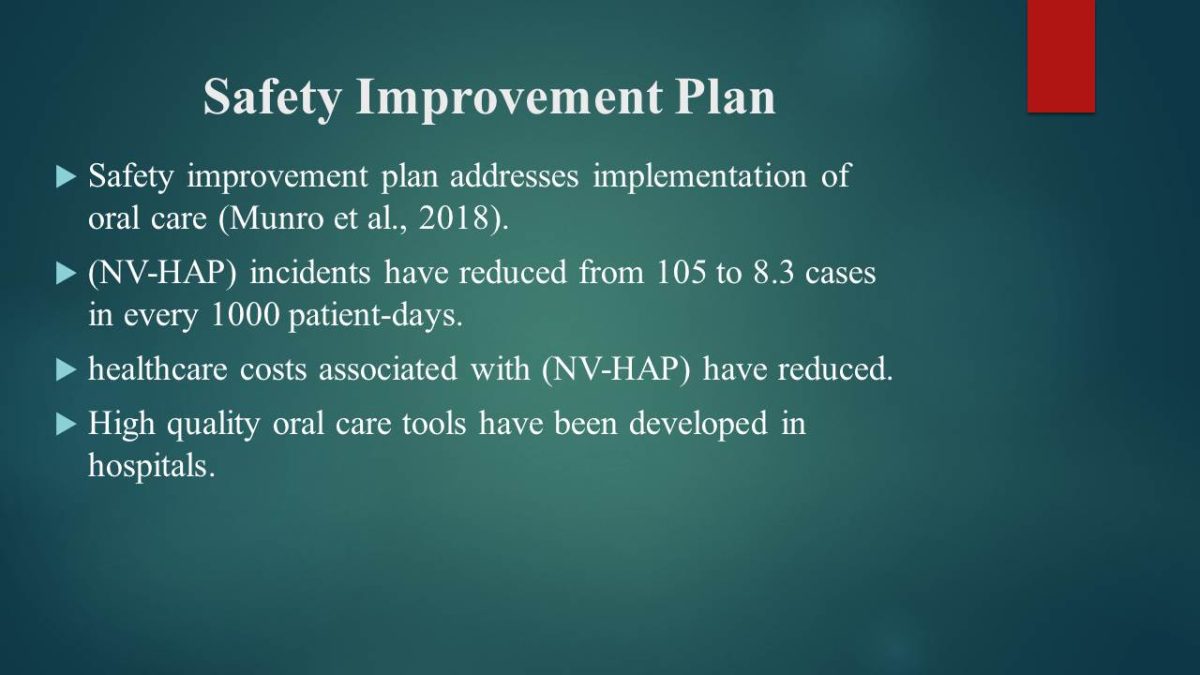
Audience’s Role and Importance
- Regular brushing and biofilm removal from teeth.
- Nurses in community living centers should brush patients’ teeth at least two times a day.
- Maintain a proper body position.
- Body positions affect various pathogenic mechanisms of VAP.
- Main pathogenic factors in VAP development are:
- Biofilm formation within the tracheal tube.
- Micro aspiration of secretions.
- While brushing teeth, it is important to either use a toothbrush, gel, moth-rinse or combination together with secretions aspirations reduces the risk of VAP.
- As a VAP preventive measure, people should avoid supine horizontal body position.
- The audience may include nurses, health specialists and patients.
- Proper operating structures in hospitals leads to:
- Reduction of nurses’ fatigue.
- Provision of high standard patient care.
- A nurse must have adequate experience for:
- Patients’ satisfaction.
- Better outcome to be achieved (Patel & Wright, 2018).
- This presentation provides the roles and importance of nurses, health specialists and patients in pneumonia care.
- When nurses follow the safety improvement for pneumonia patients, hospitalizations are minimized thus reducing their fatigue.
- Following pneumonia safety improvement plan constitutes to various positive results.
- Reduction of nurses fatigue have substantial benefit to patients as it enhances safety and quality care and constitutes better patient outcome.
- In order to accomplish better patients outcomes, there must be an equal cooperation and contribution between hospitals and nurses.
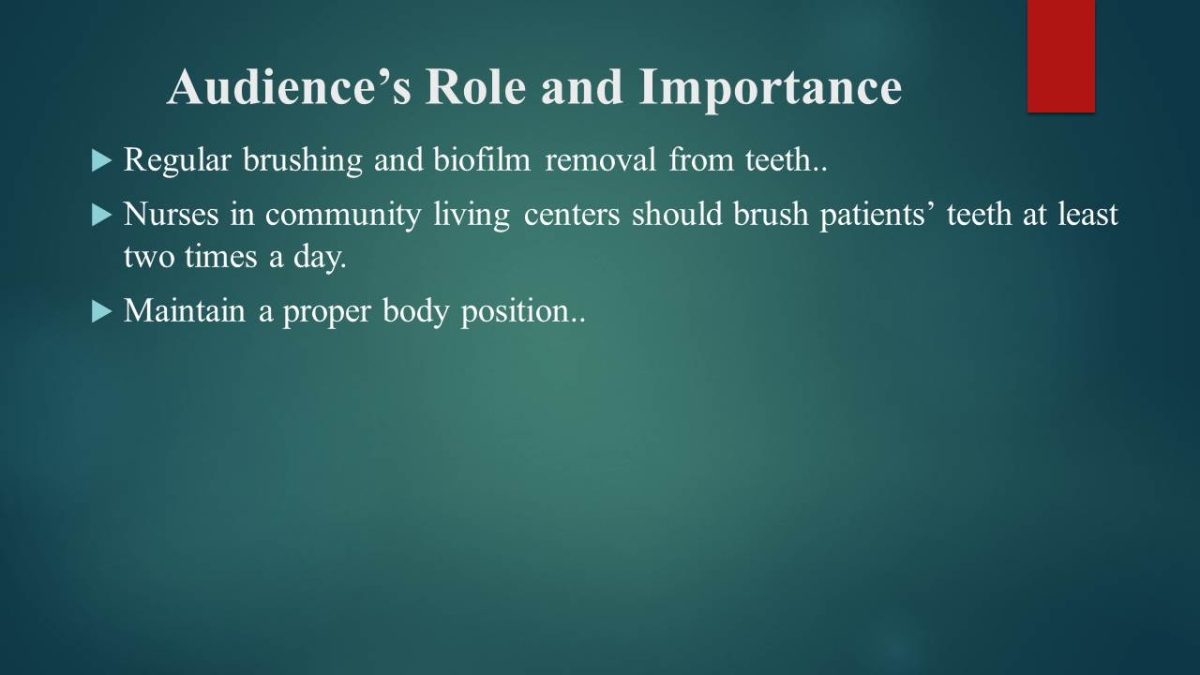
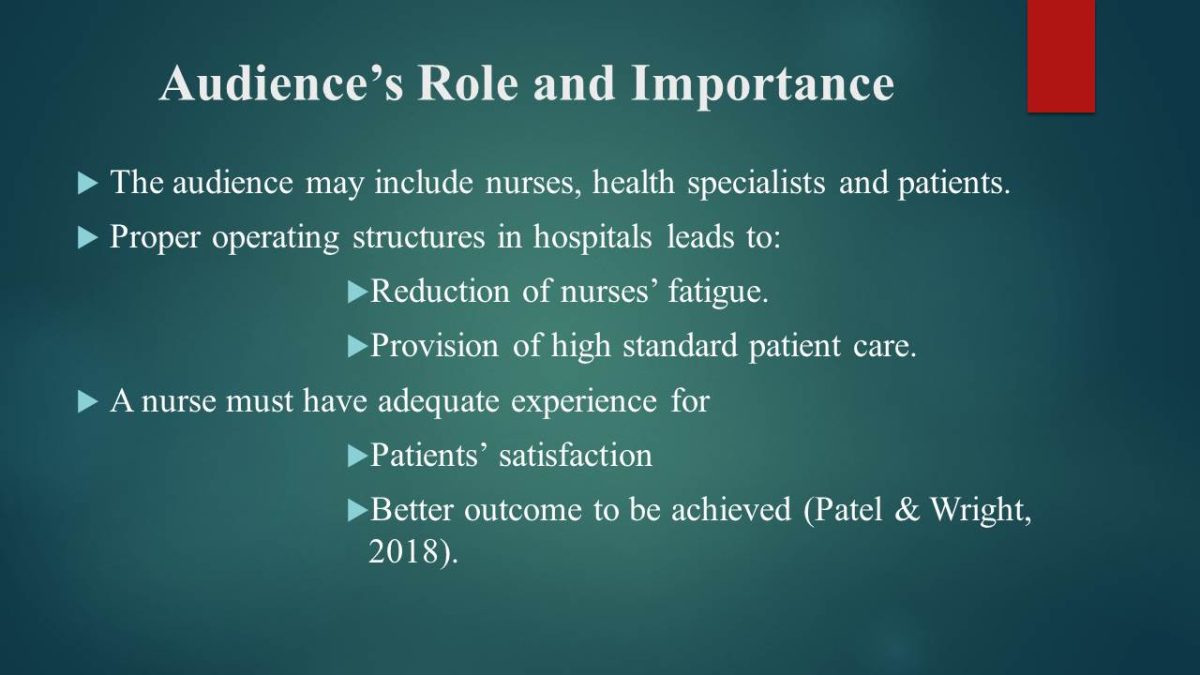
New Processes and Skills Practice
- Pneumonia skills development is the process of identifying pneumonia skill gaps.
- One major skill in pneumonia care is airway clearance.
- Under nursing interventions, nurses elevate patients’ head-beds.
- Ambulation is a process that mobilizes secretions to ease the breathing process.
- Pneumonia care skills are important as they determine the ability of health practitioners to execute safety and care to pneumonia patients.
- Various airway clearance processes include; elevation of patients’ head-beds, ambulation, humidified oxygen, splinting and breathing exercises.
- Through elevation of patients’ head-beds, the diaphragm of the patient lowers thus creation of an effective airway clearance.
- Ambulation is the ability of patients to walk without the need for any kind of assistance.
- Through ambulation, pooling of secretions are superimposed bacterial proliferation are prevented.
- Using humidified oxygen on pneumonia patients reduces the viscosity of secretions.
- The humidifier should be cleaned before use to prevent growth of bacteria.
- Fluids such as warm liquids help in the expectoration and mobilization of secretions.
- Deep breathing exercises maximizes lungs expansion and contribute to smaller airways.
- Splinting aids in deeper and more effective coughs.
- Fluids also aid in maintenance of hydration and viscosity of secretions is reduced. Normally, it is easier to cough out trimmer secretions.
- Through deep breathing exercises, overall cough productivity is improved.
- Encouraging patients to splint reduces discomfort of the chest.
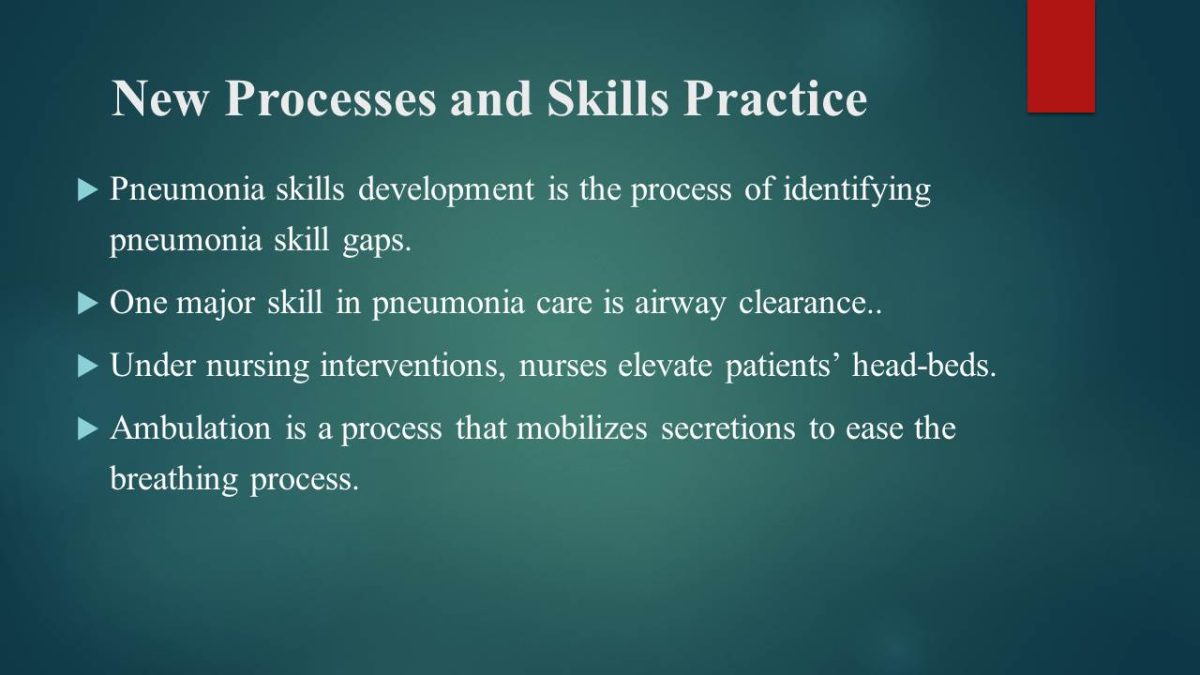
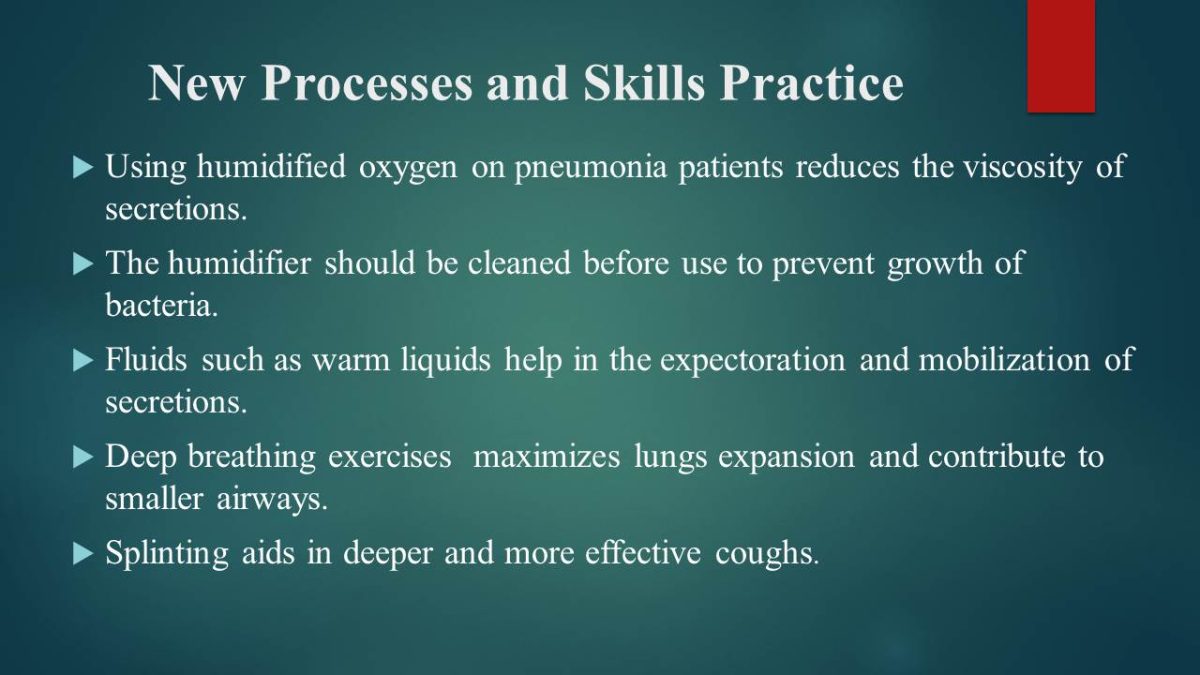
Soliciting Feedback
- I would detect non-verbal feedback during the presentation.
- Paying attention to questions asked during the presentation..
- Seek one on one feedback.
- Creating a custom feedback form with open-ended questions.
- Examples of non-verbal feedback include: if the audience looks confused, bored, excited or are nodding their heads.
- Various aspects to look at in the asked questions include:
- Do the question oppose my ideas?
- Do they indicate confusion?.
- If this is the case, then I will clarify and use more persuasive elements.
- One-on-one feedback is important because some people may be reluctant to give essential feedback due to certain reasons.
- These reasons include:
- Fear of embarrassment;
- They may not want to hurt my feelings;
- Tack of confidence;
- Fear of being wrong.
- Open-ended questions helps to request crucial feedback about my strengths and weaknesses from the audience.
- Being proactive by not allowing the feedback to be a one way information stream.
- Asking for details incase my presentation is praised.
- Striking fast despite the method I intend to request feedback.
- This method could be from a group, one on one or with a form.
- The importance of striking quickly is because memories fade very fast.
- Feed back should not be from the presenter to the audience; instead, It should be converted into a conversation.
- Instead of saying thank you when my presentation is praised, I would ask questions like, ‘ which is your best part?’
- Trough quick striking, the sooner I collect the feedback, the more accurate and detailed it will be.
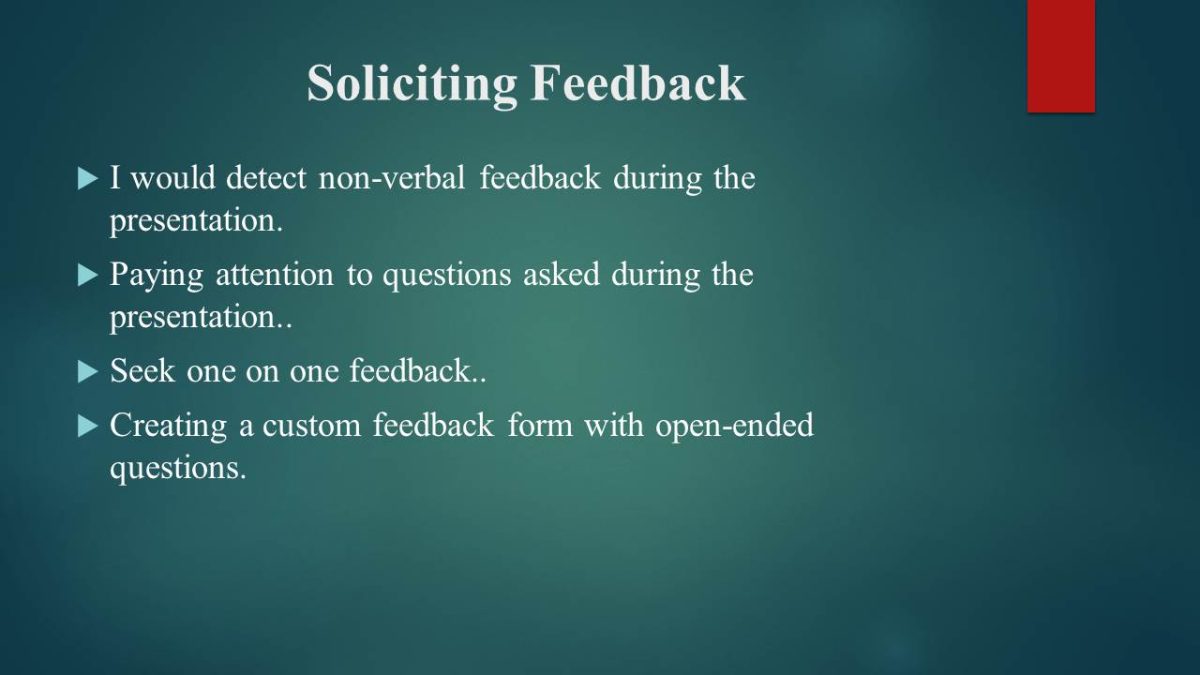
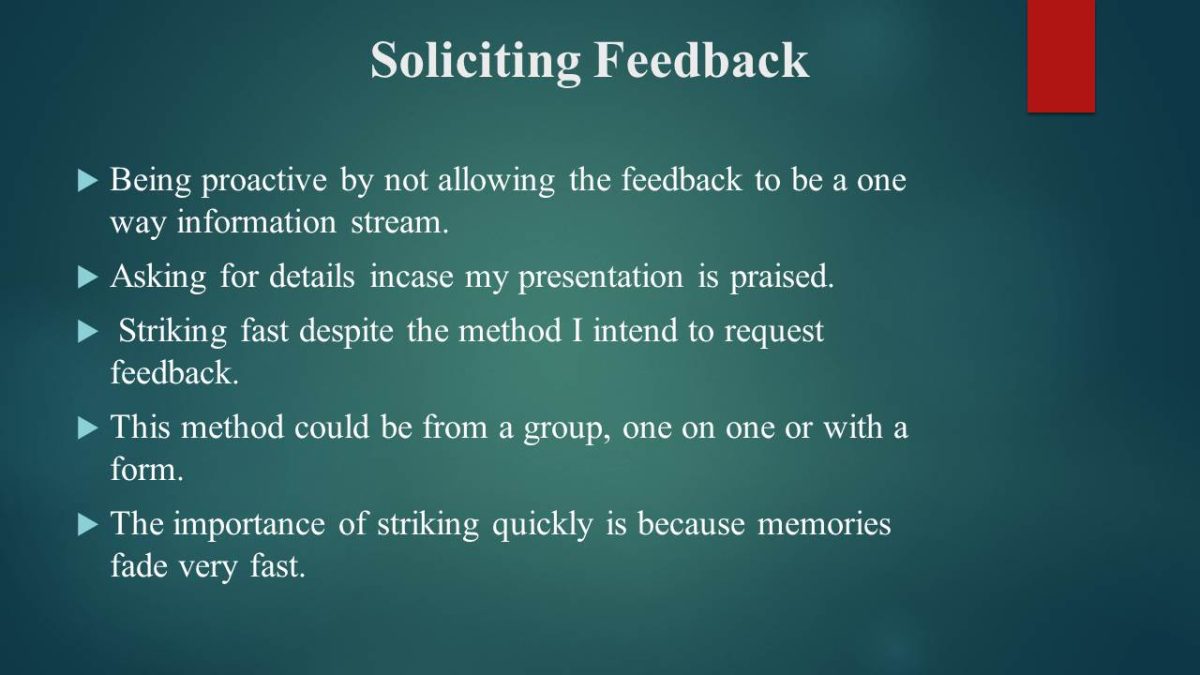
References
Munro, S., Haile-Mariam, A., Greenwell, C., Demirci, S., Farooqi, O., & Vasudeva, S. (2018). Implementation and dissemination of a Department of Veterans Affairs oral care initiative to prevent hospital-acquired pneumonia among Nonventilated patients. Nursing Administration Quarterly, 42(4), 363- 372. Web.
Patel, S., & Wright, M. (2018). Development of interprofessional simulation in nursing education to improve teamwork and collaboration in maternal child nursing. Journal of Obstetric, Gynecologic & Neonatal Nursing​, 47(3), s16– s17. Web.
Rhodes, N. J., Cruce, C. E., O’Donnell, J. N., Wunderink, R. G., & Hauser, A. R. (2018). Resistance trends and treatment options in Gram-negative ventilator- associated pneumonia. Current Infectious Disease Reports, 20(2). Web.